
A powerful headlamp for night skiing, night biking, kiwi-spotting, or other activities where a good look ahead is needed. Optional reactive lighting automatically adjusts for distance, increases battery life, but takes some getting used to. Requires a mobile device and app to access all controls, but the app won’t work reliably on all mobile devices. Great for moving fast, but overkill for slow speed activities, and definitely not for the light minimalist.
Pros
- Flood and spot LEDs
- 750 lumens max power
- USB rechargeable li-ion battery
- Up to 18 hours battery life (longer in test) depending on activity
- Reactive lighting automatically adjusts for distance and saves batteries (and eyes)
- Programmable via mobile device app with Bluetooth connection, with ready to go programs for different activities
- Continuous lighting also an option
- Single big control knob is mitten-friendly, locks securely
- Water sealed
- Quick adjust headband
- Red warning flasher on back
Cons
- One-knob control limits manual control options
- Unreliable app, won’t connect and/or function on some common mobile devices
- Continuous dimming and red flasher on/off only available in app
- No red or other night vision options
- Lowest light setting too bright for maintaining night vision, not for the light minimalist
- Short battery life compared to some alternatives, especially at high power
- Price
Here in Norway, we take our headlamps seriously—in winter at least. In summer we can pretty much leave them in the gear cave. On our shortest days in Trondheim, the sun is above the horizon for about four hours, with an hour or so of gradually fading light on either end as the sun angles down below the horizon. So for about 2 months on either side of winter solstice, a lot of our outdoor activity happens in darkness.
For me, that includes night skiing on the xc trails in the forest and bog areas within city limits here in Trondheim, with hundreds of kilometers of groomed trails, and the occasional Friday night ski into a mountain hut. Tens of kilometers of the xc trails are lighted in the evening, but outside the lighted trails and from 11 PM to dawn, you’re on your own. So, yeah, it’s nice to have a good headlamp, or two, or maybe a collection so you have one for every mood.
I’m often a minimal light kind of guy, leaving the headlamp off if there is enough moonlight or city light reflected off clouds to see the way ahead, especially when skiing on easy groomed trails when the tracks are easy to follow. When available light fails, on clear, moonless nights or in the shade of a spruce forest, I’ll go with a minimal flood light if I’m moving slow enough, just enough to see a few meters ahead. But if I’m looking down one of the steeper groomed trails or maybe hitting up one of my between-piste powder stashes, well then I want some power. 400 to 500 lumens, enough to see ahead 50 meters or so, will do the trick, but I wouldn’t say no to more.
Cue the Petzl NAO+, an upgrade on the original NAO. With a max light output of 750 lumens (more than double that of its predecessor, the NAO), divided between spot and flood LEDs, it gives plenty of light for schussing groomed downhills or cutting up powder between the trees, without going to the blinding multi-thousand lumen burn of some of the high-end headlamps used by some folks in these parts. While it shines, literally, in that role, its lowest output is actually a bit much for my taste but would probably serve well for folks that don’t mind being surrounded by a cone of darkness.
Modus operandi
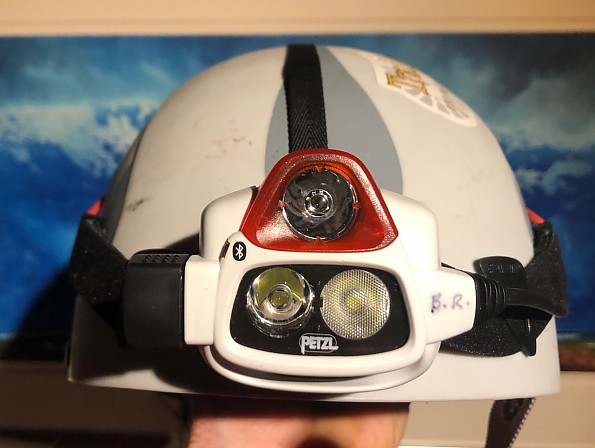
The NAO+ comes with two lighting modes, Reactive and Constant, and two levels in each mode, labelled Max Autonomy (battery life) and Max Power, herein referred to as low and high. In Reactive mode, the sensor above the LEDs detects reflected light and adjusts light output accordingly, dimming when looking at closer surfaces, including maps and other people’s faces, them powering up, including switching on the spot LED, when aimed down the trail.
The adjustment is fast enough that it can go unnoticed. However, falling snow and reflective objects, including reflective clothing on the person in front of you or even a cloud of mist from your own breath, can cause unwanted dimming or flickering.
This short video shows how the NAO+ reacts to a reflective vest:
If Reactive lighting becomes too annoying, users can switch to Constant mode, with a (putative—see below) battery life penalty. Different illumination levels may use both LEDs or the flood LED only, and there are also options for the relative mix of flood and spot lighting (described below). In reactive mode, the spot LED only comes on when illuminating greater distances, helping prolong battery life.
Manual control is via a single, square knob on the right side, at a little over 1.5 cm across big enough to operate wearing heavy mittens. Sequential clockwise twists rotate through off, low, and high levels, in that order. Holding for two seconds toggles between Reactive and Constant modes. The NAO+ always switches on in Low-Reactive mode. Because the reactive adjustments can be subtle, it's not always obvious which mode or even level you're in, you just have to remember. Twisting counterclockwise a half turn locks the headlamp securely for stowage in pocket or pack.
There is no way to switch directly from high back to low beam, instead you have to go through off to get there. This is a minor inconvenience with only two light levels, but some profiles have three levels so that it takes three tweaks of the knob to get from mid to low, via high and off. I can see that Petzl wanted to keep its OS simple, but it would seem to be pretty straightforward to be able use counterclockwise tweaks to reverse the sequence; I don’t think that would even have to interfere with the locking mechanism.

A bright LED under the red cover on the battery pack on the back of the head is on in flash mode by default, I suppose to warn approaching motorists while road-running, but also likely to annoy any companions that end up behind you. The only way to switch it off or on in either continuous or flash mode is via the mobile device app. I suspect most users, myself included, switch it off and leave it off. If there were some kind direct control on the headlamp it would be much easier to switch on when needed and off when annoying.
In reactive mode the NAO+ will dim in response to oncoming light, but its overall brightness, even on a low setting, means that users have to be extra courteous when meeting others on the trail, especially those going by natural or weak light. I usually angle it down and look away from oncomers. It's best just to switch it off if you want to stop and chew the fat.
What’s ‘appening?
The NAO+ can be reprogrammed and controlled via a Bluetooth connection using the MyPetzl Light app, available for various mobile devices. Bluetooth connectivity is switched on and off by holding the control knob for 30 seconds, and a small flashing blue light (next to the Bluetooth symbol in the photo above) indicates when it is on.
Just because the app is available and can be installed doesn’t mean it will work. I tried it out on my two-year-old iPhone 8, and it would not connect, period. Petzl’s website gives a long list of mobile devices that it is known to work with, which for some mysterious reason skips over iPhone 8, which has been around for over three years. It will, however, connect on my iPad2, which is not on Petzl’s list, but I don’t ski or hike with my iPad ready to whip out to make adjustments.
Furthermore, the custom profile part of the app does not work properly on an iPad 2; some features are disabled. I borrowed my wife's iPhone 12 and there the full app works as it's supposed to. But I don't think my wife wants me borrowing her phone every time I go out for a run, never mind a weekender or longer. So, buyer beware: check if your mobile device is compatible with the app before you whip out the plastic. If Petzl can't be bothered to ensure compatibility with an iPhone8, it may not be in a hurry to ensure compatibility with other older or newer variants of all kinds.
The app comes with 6 pre-defined profiles, best summarized in a table:
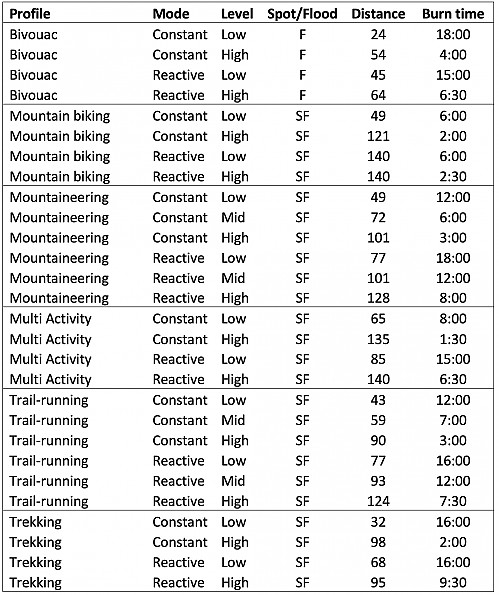
Note that there is not a simple linear relation between illumination distance and burn time, even in Constant mode, as shown in this graph: 
It makes sense that there would be some variation in estimated battery life in Reactive mode, because it depends on how much close versus distant illumination you are doing, and I’d guess that Petzl makes activity-dependent assumptions about that. For example, if you are mountain biking you’re going to be spending most of the time looking well down the trail, but with mountaineering you’ll more be looking at the snow or rock in front of you, so mountain bike burn time estimates are the shortest on the table, even at similar illumination intensities (distances).
I would think that in Constant mode the burn time would be the same for a given illumination distance, but Petzl’s estimates don’t jive with that—Petzl gives a 12-hour burn time at a 49m distance when Mountaineering, but only 6 hours at the same distance when mountain biking, both in constant mode. I turns out that each profile uses a different ratio of the flood and spot LEDs, which explains the discrepancies.
Each profile comes with a terse description of the relative light mix, for example the fine print in the Trail running profile screenshot below says "Lighting to see in front of you and for obstacle avoidance". The light flares in front of the little walking men attempt to show the relative spot-flood mix. The Trekking profile is described as "Lighting to follow your path and identify landmarks", and based on the little walking man icon seems to offer a higher proportion of spot light.

To save battery, Reactive lighting activates the spot only when aiming at something beyond some threshold distance. The Bivouac is the only profile that uses flood only in Constant mode. I would prefer to have a profile that uses absolutely minimum light on the lowest setting, for maximum battery life and some hope of maintaining night vision.
Custom profiles (if you can...)
That's where custom profiles come in—when the app functions as it should (not on my iPhone or iPad), it's possible to combine different lighting modes flexibly. Here it is possible to choose and mix and match 6 lighting options with the same names and descriptions as the standard profiles, and so presumably control the ratio of the flood and spot LED for different imagined situations.
Because of the bugs on my iPad, I used my wife's iPhone to make a night skiing profile, with minimal, moderate, and max light outputs, for slow uphill, moderate downhill, and all-in schussing, respectively. For the lowest level in both reactive and constant modes I selected the Bivouac option, which uses only the flood LED at a minimal illumination distance of 24 m with a 28+ hour run time. For the mid and high levels I went with the Trail running and Trekking options with middling and all-out maximum lighting distances.
Here's the summary screen for Constant:

And Reactive:
Live control

The app’s LIVE mode gives battery % and estimated burn time at the current setting and has a slider that allows direct control of light output in constant mode only. With the one-knob control, there is no way to manually dim or brighten on the fly—at best you’d have to get your mobile phone, or tablet, out. Needless to say, that is not very convenient while running, skiing, or doing just about anything else that involves forward motion.
Adding manual dimming by holding the knob would interfere with Reactive-Constant mode switching and Bluetooth activation/deactivation, but it sure would be nice. Maybe it’s time to consider adding another control button in the next generation.
Emergency mode
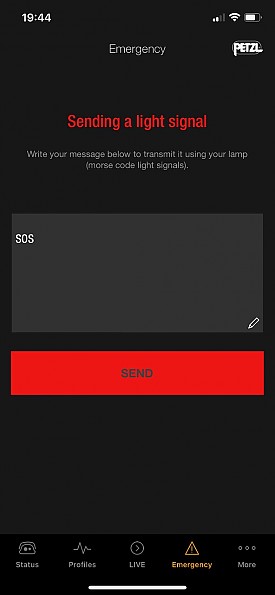
The app also offers an emergency mode. The user can enter a message up to 20 characters in length, which the app translates into Morse code and sends out using both LEDs at full power. The default message is "SOS", which is the only Morse code message that I (and I think many others) would recognize. Could come in handy some night up on the mountain, but I sure hope it never comes to that. And I hope I have a mobile device with me that will connect with the NAO+ so that I can actually use it!
Battery up!
The NAO+ runs on a 3100 mAh, USB-rechargeable Li-ion battery that rides on the back of the head, or in a warm pocket via an optional extension cord ($35).
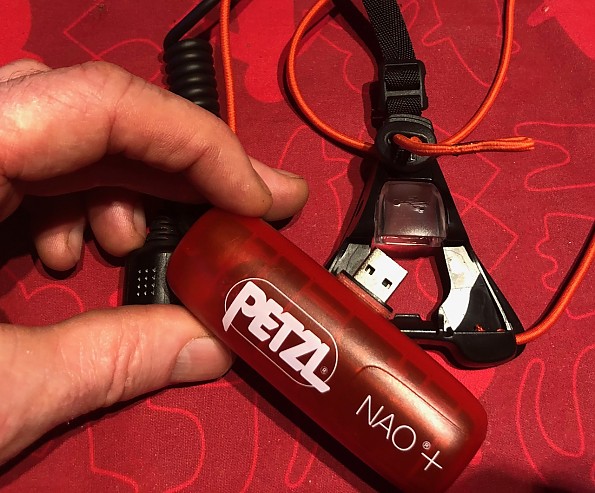
The battery snap-locks into a plastic mount on the back of the head and connects to the front end via a water-sealed connector and heavy coiled cable. The USB connector slots into a little protective alcove in the mount. Releasing the battery requires strong finger pressure on a small spring clip. A row of three LEDs on top left gives some indication of remaining battery life. The battery pack and LED assembly are water resistant to IPX4, enough to ward off rain but not tolerate immersion.
As shown in the table, Petzl specifies burn times anywhere from 1.5 to 18 hours in above-freezing temperatures, depending on the kind of use. Using the Reactive mode, which automatically brighten or dims in response to the amount of reflected light, can nearly double battery life in some uses. At low ebb the NAO+ goes into reserve mode, delivering a mere 15 lumens for 2 hours. Petzl notes that burn time estimates are for above freezing and will be shorter in colder conditions.
To test Petzl's estimated burn times, I made time lapse videos of the NAO’s performance on the low-constant (49 m) setting in both Mountaineering and Mountain Bike profiles, starting each with a fully charged battery and running until lights-out. Here’s the latter:
After about 7 hours (at 11 PM on the clock), the lamp shifts into a different mode. The camera's exposure system may have self-adjusted somewhat for the change, but when I checked on the light periodically during the test it seemed just about as bright as at the start, certainly more than the 15 lumens specified for reserve mode. According to Petzl’s numbers the lamp should have shut down after 6 hours of full illumination + 2 hours reserve, but it actually gave nearly constant illumination for over 28 hours!
Using the same illumination level in the Mountaineering profile, the NAO stepped down to a lower intensity after just shy of 13 hours and went out completely at just under 24 hours. So Petzl’s burn time estimates seem to be way off the mark, but fortunately in at least this mode much longer than specified. Nevertheless, it would be nice to have a confident, realistic estimate of how long your battery’s going to last, whether setting out from the South Col at midnight on summit day or heading into the woods for a long night ride.
Petzl sells backup/replacement batteries for about $70—enough to buy a more versatile, and maybe almost as bright, headlamp, with longer battery life, maybe even with money to spare.
Banding together

Instead of the usual broad elastic headband, the NAO+ has a hybrid elastic band / shock system with a quick adjust sliding toggle at the back of the head. An optional, adjustable, over-the-head strap can be used to keep it from slipping on head or helmet. It allows loosening the shock cord a bit for more comfort, something I really appreciate. The plastic front and back pieces are padded with closed cell foam. I have used it mostly in cold weather over a hat or buff, but with the top strap in place and the shock cord loosened it seems like it would be comfortable enough on a bare forehead.
The LED assembly ratchets down from straight ahead to about 45˚ in six stops. Keeping it tipped down a bit helps save battery in reactive mode.
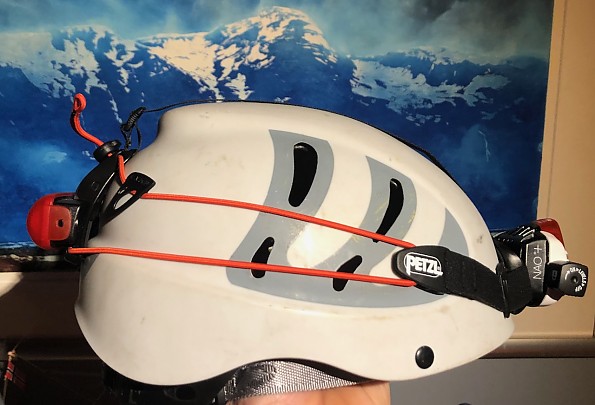
The NAO+ adapts well to my climbing helmet, which has paired clips front and back for just such a thing. My ski helmet has a single clip on the back for a goggles strap that is not compatible with the battery assembly, and nothing to help hold the front end in place, so that’s not so great. It almost wants to work with my bike helmet if I take the visor off, but would require an improvised strap around the battery pack to keep it from slipping. I guess that would be a problem for any headlamp with a rear battery pack.
Price and best use
The NAO+ is one of the techiest headlamps out there, and accordingly comes at a top shelf price, nearly $200 at full retail. I usually don't list price as a pro or a con in reviews—it is what it is—but in this case the user is paying a premium for headlamp with a supporting app that doesn't fully work as it should and is impractical to use on the fly. That just doesn't seem like a good deal to me.
At 195 grams, it won’t make it on anyone’s UL gear list, and the price tag also selects for user who really need its suite of features. Given its weight, the complexities and limitations of its app-driven OS, and its over-brightness for some situations, I see it as having a rather limited range of use. I enjoy using it on night-time ski excursions, which sometimes include trying to find a snow-buried hut in utter darkness, but once in the hut or a tent, I’d want a second, less powerful headlamp that wouldn’t blind my partners. It's nice enough for trail running, but I'm also fine with something lighter and less bright.
I’m guessing mountain bikers would be looking at even more powerful systems for night rides—my hard-charging son-in-law uses a pair of 2000-lumen lights, one on a helmet mount and one on the handlebars. I found a few favorable reviews on some caving forums but wonder if cavers might go for longer battery life.
For mountaineering, it might be a good choice for midnight-to-4 AM alpine starts, but I would think a little less light traded off for longer battery life might be as good or better, especially if the adventure wraps around into a second night out. My time lapse video suggests it could make it through a second night with judicious use, but that’s at illumination levels that can be supplied by lesser headlamps.
For night hiking and backpacking, I’d definitely go for less power and more versatile illumination modes, longer battery life, and lower weight, probably at half or less the price.
In my extensive headlamp quiver, the NAO+ is reserved for night skiing and shorter hut trips, but I'll use lighter and less powerful options for just about everything else.
Background
I have been using the NAO+ for about two months during Norway's darkest time of year, for trail running, dog walking, and an early season ski tour or two (in the mountains—as of the first week of January 2021, the ski season in Trondheim is off to a poor start). After 18 winters in Norway, I have owned and heavily used dozens of different headlamps for night skiing, running, and generally bumping about in the dark.
Source: received it as a personal gift
Don’t bother. To control profiles it links to the app!! The app that won’t connect! Waste of money.
Pros
- Bright
Cons
- Doesn’t link to app
- Overpriced for a gimmick that doesn’t work
As stated above, don’t bother.
Background
A year of getting fed up with connecting, or rather not connecting, to app
Source: bought it new
Price Paid: Too much
Your Review
You May Like
Specs
| Reactive Max Autonomy | Reactive Max Power | Constant Max Autonomy | Constant Max Power | ||
|---|---|---|---|---|---|
| Price |
MSRP: $199.95 Historic Range: $99.99-$199.95 |
||||
| Weight |
185 g |
||||
| Technology |
Reactive Lighting or Constant Lighting |
||||
| Beam pattern |
flood, mixed, or focused |
||||
| Brightness | 320 lm | 750 lm | 120 lm | 530 lm | |
| Lighting Distance | 85 m | 140 m | 65 m | 135 m | |
| Burn Time | 15 h | 6 h 30 min | 8 h | 1 h 30 min | |
| Reserve Mode |
15 lm for 2 h |
||||
| Energy |
3100 mAh Lithium-Ion rechargeable battery |
||||
| Charging time |
6 to 8 h |
||||
| Watertightness |
IPX4 (water resistant) |
||||
| Certification(s) |
AS/NZS 4268, CE, FCC, IC, ARIB |
||||


